You Are So Metal

Metals are by definition a category of chemical element that share the characteristic of forming crystalline (uniform, strong) structures that are opaque, ductile, conductive, lustrous when polished, and malleable. Almost 75% of all known elements (the periodic table) are metals. At the atomic level, they bond into molecules and combine with other metals, and are found throughout our environment in soil, rocks, water, and in plants, animals, and even in our own bodies. There is a small group of metals which play an important role in cellular function. If these essential metals are not present, the cell does not function properly or maintain its structure.
Their most significant role is in enzymes and metabolism. Our bodies are like factories, a structure that takes in raw materials and turns out various products. To use this metaphor, metabolism is the factory's conversion of raw materials into finished products: sheets of metal, nuts and bolts, leather, foam, and plastic turn into cars rolling down the assembly line. Enzymes are the specialized robots that assemble the car as they roll by, each with its own job: Tightening a bolt, moving and holding a part while it is soldered, applying paint. There are hundreds of specialized assembly robots in a modern car factory, and there are thousands of specialized enzymes in our bodies, each fine-tuned to the one specific job it has. For example, catalase is an enzyme whose sole job is to break down hydrogen peroxide into water and oxygen. Each catalase enzyme breaks down 40 million hydrogen peroxide molecules every second! This high-speed chemical reaction is the enzyme superpower.
Essential Metals and Their Functions
Some of these metals you'll recognize from the side of your cereal box, but others are less commonly known. As our understanding of enzymes grows, we are sure to discover other roles played by these essential metals. But basically, we know that certain enzyme molecules contain the following metallic atoms.
Iron
A very important part of hemoglobin, a protein molecule that transports oxygen from the lungs to the body and carbon dioxide from the body to the lungs. Extra iron can be stored in tissues for future use, but great blood loss or poor nutrition can deprive the body of iron and lead to anemia and weakness as the body's ability to transport oxygen is compromised. In children, iron deficiency leads to slower growth and even higher instances of infection. Iron can be found in seafood, seeds, nuts, meat, beans, legumes, dark leafy greens, and dark chocolate.
Zinc
A part of over 300 enzymes, zinc is an important part of gene expression, that is, how information from a gene (part of a chromosome) leads to the creation of a product, that is, our bodies. A zinc deficiency deprives cells of the ability to grow and repair injuries. Zinc can be found in meat, liver, eggs, seafood, and to a lesser degree, cereals.
Copper
Not just necessary to your house's plumbing and electrical network, copper is an important part of many enzymes. Copper helps form your hair and allows your skin and organ tissues to be elastic. Copper also allows the body to use iron. It is difficult to acquire a copper deficiency, but some forms are hereditary and lead to poor absorption of nutrients from the intestines. Animals which have been observed with copper deficiencies had anemia, skeletal deformities, and nervous system degeneration.
Manganese
This lesser-known metal is an important component of mitochondrial enzymes, those enzymes found in the inner-workings of all of your cells. Manganese is found in whole grains, cereals, fruits, and vegetables. As with copper, manganese deficiencies are extremely rare, but when observed in animals, leads to poor reproduction, deformities in bone and cartilage, and problems with glucose metabolism.
Molybdenum
This metal was given a name derived from the Greek for lead, since it was often confused for that far more abundant metal. It plays a role in many enzymes. While molybdenum is found in many foods, its presence is closely associated with how much of the element is found in the soil where those foods were grown or raised. Deficiency can lead to toxic reactions to sulfites in food, since the enzyme to break down the sulfites is missing.
Selenium
This metal's role in enzymes is still being researched, but one known role it plays allows our bodies to benefit from the antioxidant (anti-rusting, therefore, anti-breaking-down) aspects of Vitamin E. It is also found in the enzyme that breaks down hormones produced by the thyroid gland.
Chromium
Chromium doesn't give us nice shiny bumpers but some research shows that it helps moderate our glucose levels through its role with insulin. This essential metal is somewhat controversial, as not all research seems to indicate that it plays a vital, biological role.
Metals not only form parts of critical enzymes in our bodies, they also play a role in the survival of microorganisms. Research into bacterial metabolism, for example, has not only allowed us to learn more about how our bodies use metals, but also how metals can be used to destroy harmful bacteria. Future posts will explore how one metal plays a role in infection control.
![EOScu Logo - Dark - Outlined [07182023]-01](https://blog.eoscu.com/hubfs/Eoscu_June2024/Images/EOScu%20Logo%20-%20Dark%20-%20Outlined%20%5B07182023%5D-01.svg)

![[infographic] How Copper Kills Bacteria Download and share!](https://no-cache.hubspot.com/cta/default/216314/interactive-178388176798.png)


